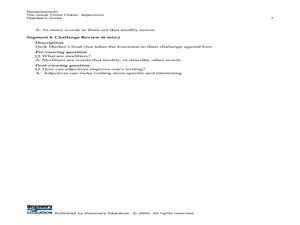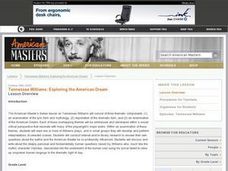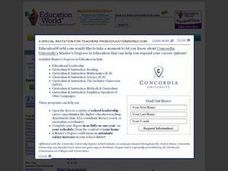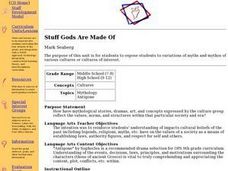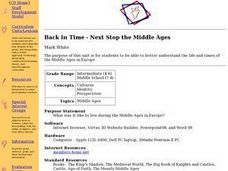Curated OER
The Great China Chase: Adjectives
Stories are created, by students, using a variety of adjectives. 3-5th graders will learn about adjectives and use their new knowledge to create ad-lib stories to share with the class demonstrating their mastery of adjectives, indefinite...
Curated OER
Using Effective, Evocative Writing as a Model
Students analyze the author's style to learn techniques for strengthening their own writing. They re-read "Music in the Fields" and highlight images that create vivid pictures in their minds-places where Young "shows, not tells" and...
Curated OER
Tennessee Williams: Exploring the American Dream
Young scholars read and analyze selections of Tennessee Williams' work. They write journal responses, conduct Internet research, perform various scenes from one of Williams' dramas, and create a presentation.
Curated OER
Literature: Isabel Allende
Students watch and respond to a Bill Moyers Now video on the Chilean author, Isabel Allende. They brainstorm a list of recent events that might inspire writers and choose one to write about in poetic, diary, or short story form.
Curated OER
Poet Naomi Shihab Nye
Students read and analyze poetry by Naomi Shihab Nye. They define stereotypes, view and discuss a video interview with Nye, present an oral reading of a poem, and write a persuasive letter to an author.
Curated OER
Heroes Or Role Models?
Students recognize that "heroes" and "role models" are not synonymous terms. By analyzing heroes of other cultures and periods, they determine that many heroic figures, mythic or historical, rather than providing a model of a societal...
Curated OER
Peace and Perspective through Poetry: The Dream of Peace in the Middle East
Students use poetry to understand conflict in the Middle East. In this poetry lesson, students read persona poems and use the poetry and a novel as mentor text to guide their own poem about peace in the Middle East.
Curated OER
Make a Paper Mache Bowl
Students create a paper mache bowl. In this paper mache lesson, students use wallpaper paste, newspapers, and paint brushes to construct a paper mache bowl. Students decorate their bowl with unique designs.
Curated OER
The Relationship Between Zen And Haiku Aesthetics
High schoolers examine the principles of Haiku as they relate to idealss found in Zen Buddhism in this High School lesson. The lesson concludes with the creation of individual haikus by each student.
Curated OER
Scenes of Reverence: The Virgin of Guadalupe
Students learn the history of Christianity in New Spain. They learn the story and significance of the Virgin of Guadalupe. They compare and contrast images of the Virgin and religious art to European counterparts.
Curated OER
Guidelines for Governing: Utopia and The Prince
Students explore the power of the Church in government. In this literature lesson, students read Sir Thomas More's Utopia and Niccolo Machiavelli's The Prince. Students respond to questions regarding the works and discuss them.
Curated OER
Make A Mummy: The Science of Mummification
Students research the history of mummification. They work together to create an apple mummy. They write a paragraph about what they gathered while doing the experiment.
Curated OER
A Lucky Break
Students complete activities where they identify and decipher common phrases that are related to poultry and then cook drumsticks as a class. In this poultry lesson plan, students also read the history of the chicken and create idioms.
Curated OER
The Far Reaches of Greek Culture
Ninth graders study the culture of Greece. In this World History lesson, 9th graders research specific data in relation to Greece. Students create a presentation of their findings for their class.
Curated OER
Stuff Gods Are Made Of
Students examine different myths of various cultures around the world. Using artwork, they discuss the artistic designs and develop hypothesize about their importance. They use the internet to research myths they are aware of and share...
Curated OER
Origami Paper Fun
Students explore the art of Origami. They listen to various stories about Japan, create Origami shapes by following step-by-step directions, sing Japanese songs, locate Japan on a map, and take a quiz.
Curated OER
Back in Time - Next Stop the Middle Ages
Learners are introduced to the Middle Ages through Powerpoint presentations and books. During the presentations students work on various reading skills by reading made up papers about the Middle Ages detailing certain events in history.
Curated OER
Poisoned Chalice
Students explore espionage. For this current events lesson, students research various Web sites for information about the history of spy work, Anglo-Russian relations, and spy gadgets.
Curated OER
Exploring the Night Sky: Fall/Winter
Students explain how moon phases occur. They explain three ways that the night sky has been used through history. Students locate some of the constellations in the night sky. They discuss stories and myths surrounding stars.
Curated OER
Fields of Candy Bars
Pupils research and write about the origins of the ingredients in candy bars. They taste them and describe what they are tasting. They use descriptive words to write a paragraph describing the candy bar. They research ingredients in...
Curated OER
Corn in Legend and Myth
Seventh graders compare myths and legends about corn and use creative abilities to act them out. In this corn legends lesson, 7th graders read background information about corn and its importance. Students work in groups to research...
Curated OER
Studies of the Eastern Worlds: Japan
Seventh graders, in their study of Japan, examine and discuss the effect the atomic bomb had on Japan. They watch videos and then read the story of Sadako and her magic cranes. They make their own origami cranes and write a paragraph on...
Curated OER
John Paul II: Statesman of Faith
Students view a documentary on Pop John Paul II. He is the spiritual leader of almost one billion people worldwide and beloved ambassador of peace to untold millions more. After viewing, students discuss what they saw and create a...
Curated OER
Who Built the Pyramids?
Students examine the two theories on how the pyramids at Giza were built. They watch a video on pyramids, take notes, and write a five-paragraph essay on how they think the pyramids were constructed.


